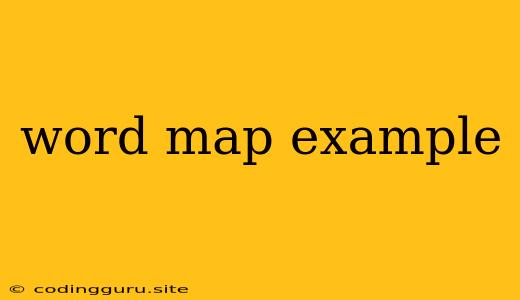Word Map: A Powerful Tool for Visualizing and Understanding Concepts
Have you ever struggled to understand a complex topic or find it difficult to remember key terms? A word map, also known as a concept map, can be a valuable tool to help you visualize and understand concepts in a more engaging and memorable way.
What is a Word Map?
A word map is a visual representation of a topic or concept using keywords, phrases, and connections to illustrate relationships between different ideas. It's like a mental map of your understanding, helping you to see the big picture and connect the dots.
Why Use a Word Map?
Word maps offer several benefits for learners and educators:
- Improved Comprehension: By visually organizing information, word maps help you to identify the key concepts and relationships within a topic.
- Enhanced Memory: The visual nature of word maps makes information more engaging and memorable, helping you to retain knowledge more effectively.
- Active Learning: Creating a word map encourages active engagement with the material, promoting deeper understanding and critical thinking.
- Collaboration: Word maps can be used collaboratively, allowing individuals to share their understanding and build upon each other's knowledge.
How to Create a Word Map
Here's a simple guide to creating your own word map:
- Choose a Topic: Start with a specific topic or concept you want to explore.
- Identify Key Terms: Brainstorm the key words and phrases related to your chosen topic.
- Organize Keywords: Arrange the keywords in a hierarchical structure, starting with the main concept at the top and branching out to related ideas.
- Draw Connections: Use lines, arrows, or other visual connections to show the relationships between different keywords. You can use different colors, shapes, or sizes to emphasize specific ideas.
- Add Details: Include brief definitions, examples, or additional information to enhance your understanding.
Example: Word Map for "Ecosystem"
Let's create a simple word map for the concept of "Ecosystem":
Ecosystem
|
---------------------
| | |
Biotic Abiotic Interactions
Factors Factors
(Living) (Non-living)
| | |
Plants Animals Competition,
Producers Consumers Predation
(e.g., trees) (e.g., deer) Symbiosis
This word map shows the main concept "Ecosystem" and its major components: biotic factors (living organisms) and abiotic factors (non-living components). It also shows the interactions that occur within an ecosystem, such as competition, predation, and symbiosis.
Using Word Maps in Different Contexts
Word maps can be used in various educational and professional settings:
- Classroom Learning: Students can create word maps to explore concepts in science, history, literature, and other subjects.
- Research Projects: Researchers can use word maps to organize their thoughts and ideas before writing research papers or presentations.
- Business Meetings: Teams can use word maps to brainstorm ideas, map out projects, or identify key stakeholders.
Tips for Effective Word Mapping
- Keep it simple: Don't try to include too much information on a single map.
- Use clear and concise language: Choose keywords and phrases that are easily understood.
- Be creative: Use colors, shapes, and symbols to make your map visually appealing.
- Review and revise: Once you have created your map, take time to review and revise it, adding or removing information as needed.
Conclusion
Word maps are a powerful tool for visualizing and understanding concepts, promoting active learning and enhanced memory retention. By organizing information in a visual and engaging way, word maps help you to connect ideas, identify key relationships, and deepen your understanding of complex topics. Whether you're a student, researcher, or professional, word maps can be a valuable tool for learning and communication.
